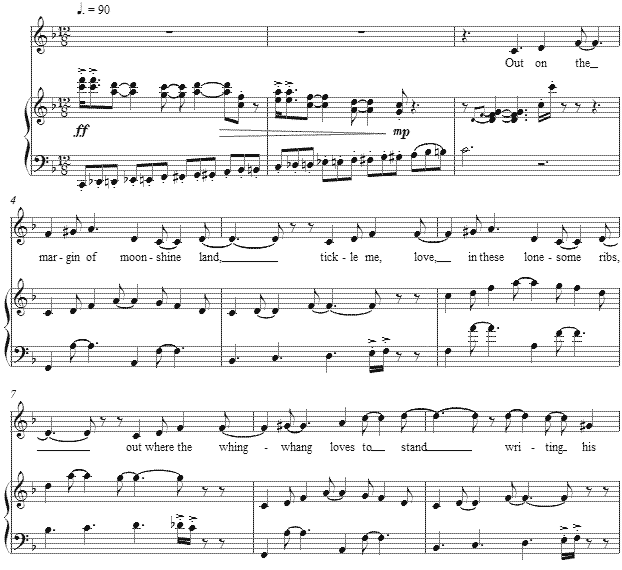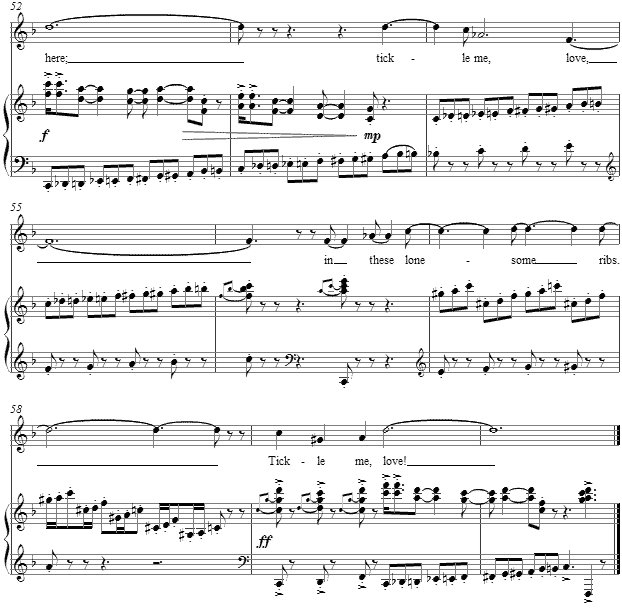Music and Texts of GARY BACHLUND
Vocal Music | Piano | Organ | Chamber Music | Orchestral | Articles and Commentary | Poems and Stories | Miscellany | FAQs
The Lugubrious Whing-Whang - (2009)
James Whitcomb Riley
for medium or low voice and piano
Out on the margin of moonshine land,
Tickle me, love, in these lonesome ribs,
Out where the whing-whang loves to stand,
Writing his name with his tail on the sand,
And wiping it out with his oogerish hand;
Tickle me, love, in these lonesome ribs.
Is it the gibber of gungs and keeks?
Tickle me, love, in these lonesome ribs,
Or what is the sound the whing-whang seeks,
Crouching low by the winding creeks,
And holding his breath for weeks and weeks?
Tickle me, love, in these lonesome ribs.
Aroint him the wraithest of wraithly things!
Tickle me, love, in these lonesome ribs,
'Tis a fair whing-whangess with phosphor rings,
And bridal jewels of fangs and stings,
And she sits and as sadly and softly sings
As the mildewed whir of her own dead wings;
Tickle me, dear; tickle me here.
Tickle me, love, in these lonesome ribs.[ 4 pages, circa 2' 40" ]
James Whitcomb Riley
James Whitcomb Riley (1849-1916) was an American writer and poet, known variously as the "Hoosier Poet", "National Poet" and the "Children's Poet." Riley began writing humorous and sentimental verse in an "Indiana dialect" for the Indianapolis Journal (1875). Riley was a bestselling author during the early 1900s and earned a steady income from royalties; he also traveled and gave public readings of his poetry. The text was first published in Riley's collection, Rhymes of Childhood, New York, Charles Scribner's Sons, 1898. I shall leave it performers to fathom the depths of this delightful nonsense of a most American sort, except to point out that the scene takes place "on the margin of moonshine land" and the repeated urging of the speaker is to plead "tickle me, love."
The 12/8 meter yields that light, syncopation reminiscent of swing yet squared here and there for emphasis. The accompaniment is mostly two lines, a bass and counterpoint to the vocal line, the introduction which is also used in bridges merely adding parallel fourths to the texture. The two measure-long gesture ending in secco sixteenth notes emphasizes a foreshortened phrase, repeated by various means such as octave displacement such that the shape and its inverse later make up much of the accompaniment itself.
The second verse is followed by a repetition of the text for emphasis and the repeat of the introductory gesture lengthens the bridge to the third verse.
A last repetition repeats again the humorous line which Riley uses as his rondo-like thema. The chromatic half steps "laugh" and do the gesture at measure 57 and earlier in anticipation of that which is demanded by the speaker, "Tickle me, love...."
The score for The Lugubrious Whing-Whang is available as a free PDF download, though any major commercial performance or recording of the work is prohibited without prior arrangement with the composer. Click on the graphic below for this piano-vocal score.



